IN SEARCH OF THE GREAT BEARS By Tim Williams (travel article)

Tim and Gloria Williams
From August 23 to September 2, 2013, Gloria and I took part in a ten-day cruise with the sailboat the “Maple Leaf”, making forays into waterways and on to islands east and north of the uppermost tip of Vancouver Island. The area of exploration was the “Great Bear Rain Forest” on the British Columbia mainland east of Haida Gwai and south of the Alaskan Panhandle, from the Broughtons as far north as Carter Bay. The tour touched on many different aspects of nature and life in the province’s northern coastal areas. It was an exhilarating experience, offering spectacular views of nature and opening up new perspectives while deepening comprehension of dimensions likely to grow in importance.
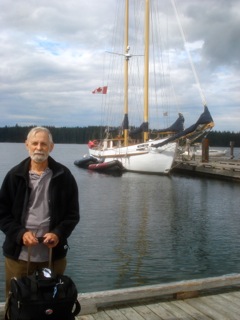
Our many photos record the appearance of the “Maple Leaf”, a handsome ninety-two foot schooner originally built as a racing vessel, then used as a halibut fishing boat and finally refitted as a tourist boat for four couples (eight passengers) and a crew of five. On reading the advertising material, I wondered about accommodation and it did seem spartan at first. Cunningly and beautifully refitted, the passenger quarters, previously the hold for halibut, consisted of four sleeping sections containing two bunks each, the whole divided by a passageway leading to the two toilets. Shortly after falling asleep the first night, I felt hemmed in. Gloria kindly exchanged bunks, clambering up to the space above. We quickly got used to manoeuvering in the narrow confines (for example to put on and take off rain pants) and soon all eight of us ignored the occasional sight of strange of other people’s limbs or strange nightwear. While some of us snored, habituation or melatonin solved the problem. We were all middle aged or older and beyond worrying. There was no problem of seasickness, as some feared; the captain was alert to storm danger and we encountered only a moderate swell, being mostly protected amongst islands and inlets.
The crew was perfect. Captain James Warburton is a man of about thirty-five who after high school had started a sailing career on tugboats and graduated to control of a larger vessel requiring skills in navigation, public relations, selection of destinations needing in-depth explanation, photography and much more. He performed impressively. His number two, the Nova Scotian first mate Nick Sinclair, backed him up in all things and added particular knowledge of engines. A naturalist, Mary Morris, brought her effervescent, articulate personality to the indispensable task of lecturing and counseling us on a wide spectrum of wildlife, plants and other aspects of geography. The Albertan cook James performed wonders in a small space, producing dishes worthy of a first-rate restaurant and accompanying them with humorous commentaries; his broad education suggested the British Columbia tourist trade was in good hands. Skye, a beautiful young student from Chelsea, Quebec, assisted capably and swiftly with all aspects of housekeeping; her interest in First Nations was stimulating. The group was solicitous and knowledgeable, leaving no room for complaint and earning praise from all.
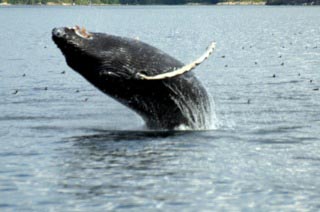 As promised in the lavish publicity material (Maple Leaf Adventures), nature surfaced thrillingly in our face from the word go. As soon as we left the small town of Port McNeill, a glorious sunset accompanied our course south-eastwards toward the Broughtons and a large group of orcas (killer whales) was clearly visible. Several days later – in what for me remains the highlight - gigantic humpback whales surrounded our stationary boat. Eagerly listening to their communications, we listened reverentially, running back and forth from one side of the boat to the other as the whales swam under and beside us, surfacing to breath and breach in unbelievable proximity. The immense creatures seemed to be paying us a visit; we marveled at these intimate encounters, which recurred several times in succeeding days. The experience outclassed previous views from a distance in Hawaii and the absence of sightings off Quebec’s Tadoussac.
As promised in the lavish publicity material (Maple Leaf Adventures), nature surfaced thrillingly in our face from the word go. As soon as we left the small town of Port McNeill, a glorious sunset accompanied our course south-eastwards toward the Broughtons and a large group of orcas (killer whales) was clearly visible. Several days later – in what for me remains the highlight - gigantic humpback whales surrounded our stationary boat. Eagerly listening to their communications, we listened reverentially, running back and forth from one side of the boat to the other as the whales swam under and beside us, surfacing to breath and breach in unbelievable proximity. The immense creatures seemed to be paying us a visit; we marveled at these intimate encounters, which recurred several times in succeeding days. The experience outclassed previous views from a distance in Hawaii and the absence of sightings off Quebec’s Tadoussac.
Other animals later on were to be of equal interest. We saw many seals and some sea lions and river otters now braving the sea. Finding bears was more difficult, but after a day of fruitless searching in a more northerly location we made several sightings of black ones hunting for fish in an estuary; later on that afternoon we saw a much larger brown grizzly. Our dauntless Australian fellow passengers, who had the energy to go out very early in kayaks, saw a couple closer up. 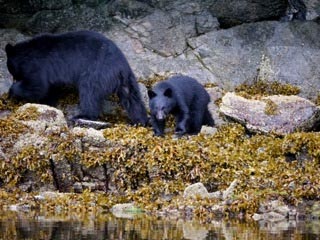 In a much smaller estuary farther north, travelling in the two zodiacs we were by then quite used to, we caught a glimpse of a wolf; he promptly retreated, but there arose behind the trees a sudden symphony of cacophonous howling and baying that went on for several impressive minutes. We came across numerous wolf and bear tracks in the sand left empty at low tide, showing that both regularly frequented it to feed on salmon. Those fish, in their various kinds, are in many ways the basis of the food chain. We saw them jumping in several river mouths as they swam up to spawn and lying around moribund or dead in estuaries or on river banks, many impressively large. The recital of animals observed has to include many kinds of gulls, pigeon guillemots, murrs, kingfishers and of course eagles and osprey, whose big nests crowned the very top of big conifers; the many other birds mentioned by our naturalist Mary would expand this list massively.
In a much smaller estuary farther north, travelling in the two zodiacs we were by then quite used to, we caught a glimpse of a wolf; he promptly retreated, but there arose behind the trees a sudden symphony of cacophonous howling and baying that went on for several impressive minutes. We came across numerous wolf and bear tracks in the sand left empty at low tide, showing that both regularly frequented it to feed on salmon. Those fish, in their various kinds, are in many ways the basis of the food chain. We saw them jumping in several river mouths as they swam up to spawn and lying around moribund or dead in estuaries or on river banks, many impressively large. The recital of animals observed has to include many kinds of gulls, pigeon guillemots, murrs, kingfishers and of course eagles and osprey, whose big nests crowned the very top of big conifers; the many other birds mentioned by our naturalist Mary would expand this list massively.
The second day we visited a member of the local First Nations tribe at Tracy anchorage where he delivered a lecture in the form of a native myth. 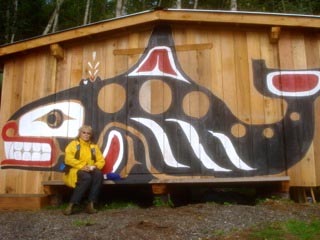 One would need to search for archetypical meanings to comprehend it fully, but clearly life in the old days had been hard and often violent. Our host Darcy made lunch for us by roasting self-caught salmon and halibut, closing a very pleasant encounter, the first in his planned business endeavor using his newly built and painted log house. In their useful introductory tour d’horizon our crew had been anxious to expound their politically supportive views about First Nations affairs to an older passenger audience with more conservative opinions. Where one crew member mentioned that Canadian settlers or even authorities may have contributed to early decimation of Indians by means of blankets poisoned with smallpox (a speculation possibly based on actions farther east or south), the vessel’s excellent library contained works reporting the disease had existed prior to the white man’s arrival. Two of the other couples laid greater stress on the need for some First Nations to improve self-governance and show more initiative in confronting inevitable challenges in a changed economy and society. That said, the evidence of very early native occupancy of the land and the need for help to meet challenges introduced by others was all around us. We saw pictographs on rock faces symbolizing First Nations’ arrival long ago, as if in juxtaposition to Alexander Mackenzie’s chiseled announcement of his sighting of the Pacific in 1793. A stop in Bella Bella, an all-First-Nations town, conveyed mixed messages: impressive municipal institutional buildings beside run-down or unkempt household dwellings, a burned-out general store destroyed by vandals and friendly greetings by the local people encountered on the streets and native fishermen on the dock.
One would need to search for archetypical meanings to comprehend it fully, but clearly life in the old days had been hard and often violent. Our host Darcy made lunch for us by roasting self-caught salmon and halibut, closing a very pleasant encounter, the first in his planned business endeavor using his newly built and painted log house. In their useful introductory tour d’horizon our crew had been anxious to expound their politically supportive views about First Nations affairs to an older passenger audience with more conservative opinions. Where one crew member mentioned that Canadian settlers or even authorities may have contributed to early decimation of Indians by means of blankets poisoned with smallpox (a speculation possibly based on actions farther east or south), the vessel’s excellent library contained works reporting the disease had existed prior to the white man’s arrival. Two of the other couples laid greater stress on the need for some First Nations to improve self-governance and show more initiative in confronting inevitable challenges in a changed economy and society. That said, the evidence of very early native occupancy of the land and the need for help to meet challenges introduced by others was all around us. We saw pictographs on rock faces symbolizing First Nations’ arrival long ago, as if in juxtaposition to Alexander Mackenzie’s chiseled announcement of his sighting of the Pacific in 1793. A stop in Bella Bella, an all-First-Nations town, conveyed mixed messages: impressive municipal institutional buildings beside run-down or unkempt household dwellings, a burned-out general store destroyed by vandals and friendly greetings by the local people encountered on the streets and native fishermen on the dock.
Spurred on by all these interesting impressions, I devoured some of the many books in the ship’s excellent collection including those on Captain George Vancouver, the Alaskan explorer Steller, several memoirs by oldtimers, the eloquent analytic picture books of Ian McAllister (on wolves, bears and salmon in particular) and several others including John Vaillant’s gripping tale of a logger turned ecologist. Intellectual excitement did not prevent me from noticing how different we passengers all were. A trip of this sort necessarily throws one together rather intimately with a motley group. The first people encountered were two middle-aged Australians, he a chartered accountant with a mining company, she also an accountant. They were admirable – articulate, eager to explore all facets of Canadian life and hence much-travelled in our and other countries, well armed with camera and expertise in kayaking and in every way agreeable travel companions. A couple from the Canadian prairies was equally outgoing and very forthright, he a plumber, she a medical assistant; like the Australians, their views reflected a private enterprise background emphasizing personal responsibility for one’s challenges in life as opposed to governmental involvement. This was probably also where the last couple was coming from. He was a companionable but taciturn glass manufacturer from Kansas on his first outing beyond the continental U.S.A, she an attractive, courteous matron, both friendly and well-spoken but quietly reactive rather than talkative. We all got along well and enjoyed the nightly libations and chatter in the exiguous confines of the small eating area. Gloria made a lively contribution to the discussions, while I – at seventy-six a decade or two older than the others - had the uneasy impression my rather lecturing approach and interest in books, generalizations and political aspects suggested academia. “How to become a fuddy-duddy”?
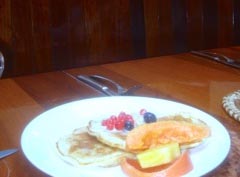 This is the place to mention the outstanding cuisine offered by the cook James, a thirty something graduate of a technical institute in Alberta and now a cook resident (like most of the crew members) in Victoria. His elegantly presented dishes, carefully explained, reflected good choice of materials and menus; his discourse suggested a widely educated background. If this is what cooks in B.C. are like, the Canadian tourist industry is in fine competitive shape! In between the three meals and two “happy hours”, we continued our explorations. Early on we found ourselves amongst giant red cedars, big enough at their base for some of us to crowd into the hole at their bottom, where bears often seek refuge in the winter.
This is the place to mention the outstanding cuisine offered by the cook James, a thirty something graduate of a technical institute in Alberta and now a cook resident (like most of the crew members) in Victoria. His elegantly presented dishes, carefully explained, reflected good choice of materials and menus; his discourse suggested a widely educated background. If this is what cooks in B.C. are like, the Canadian tourist industry is in fine competitive shape! In between the three meals and two “happy hours”, we continued our explorations. Early on we found ourselves amongst giant red cedars, big enough at their base for some of us to crowd into the hole at their bottom, where bears often seek refuge in the winter. 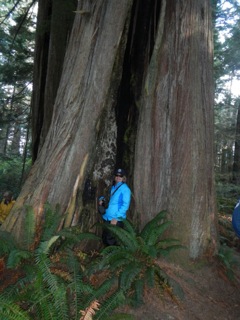 The extent of devastation when forests were clear cut was obvious. With the zodiac, we zoomed past endless but often beautiful rocky coasts. Only every now and then was there a beach. During our lengthy inspection of one near Cape Caution, we separated and, everyone in his or her own world, examined minutely the flotsam and jetsam of washed-up logs, the myriad of shells and many different kinds of seaweed, the colorful world of pebbles and the occasional piece of industrial material, some perhaps from Japan. At the forest’s edge, tangles of shrubs, mixed conifers and deciduous trees and sundry other vegetation grew thickly, including very edible huckleberries and a kind of wild blueberry.
The extent of devastation when forests were clear cut was obvious. With the zodiac, we zoomed past endless but often beautiful rocky coasts. Only every now and then was there a beach. During our lengthy inspection of one near Cape Caution, we separated and, everyone in his or her own world, examined minutely the flotsam and jetsam of washed-up logs, the myriad of shells and many different kinds of seaweed, the colorful world of pebbles and the occasional piece of industrial material, some perhaps from Japan. At the forest’s edge, tangles of shrubs, mixed conifers and deciduous trees and sundry other vegetation grew thickly, including very edible huckleberries and a kind of wild blueberry.
A memorable visit was the one to Namu, the location of a long since abandoned fish cannery, one of scores closed to centralize operations in Vancouver or later because of the decline of salmon stocks. It was eerie to wander among empty buildings, peer at equipment and sundry objects abandoned from one day to the next, speculate about the lives lived in forsaken houses and dormitories and stumble across ribald jests penned here and there as if to entertain later visitors from another planet. A tiny colony of squatters had established themselves among the ruins, profiting from the shelter and living off ramshackle vegetable gardens and the occasional visitor. They were to be evicted shortly.
Another stop was at a federally administered lighthouse near Bella Bella. From the female keeper we learned there were twenty-seven still manned on this coast, providing information to the meteorologists and any sailor who cared to ask. We saw several cruise liners and not a few fish and pleasure craft, though the general impression was usually of a vast and silent wilderness, another world from our cosseted southern existence. Nearby an official of the Department of the Environment monitored seismography in fear of an earthquake. And indeed signs warning of tsunamis and giving cautionary instructions were visible in all agglomerations. On the water coast guard vessels patrolled the waters as best they could.
With at least two major outings each day, there were plenty of surprises, including a dip in natural hot springs enclosed in some natural outcroppings near King Island. Almost in the buff, we were getting to know each other better. At Echo Bay we inspected an amateur museum created by a pioneer called Billy. His collection of bottles, fishing and logging gear, cutlery and crockery, posters and magazines and much more testified eloquently to the passage of time and the evanescence of human striving. On the traces of early western explorers such as Captain Vancouver, we marveled at the way they overcame hardships and navigated not only physical shoals but the challenges of contacts with First Nations and foreign rivals. Can we be as persistent in grappling with today’s challenges?
As the nine days wore to a close we looked forward to liberation from the early risings but were sad to leave behind the drama and beauty experienced. 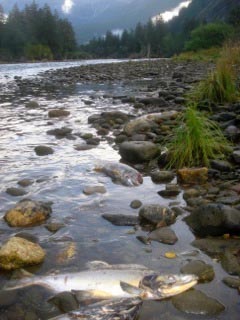 Intellectually, the trip had stimulated reflection on topics rationally registered but not hitherto experienced on the spot. How choose between development and environment? How justified were some First Nations and many others to object to the proposed Enbridge pipeline through central B.C. and the offshore inlets and islands? How much and in what form should continued exploitation of the forests take place, given the importance of a wooded environment to other living things and the length of time reforestation takes? How can First Nations communities best be assisted to help themselves to retain and adapt cultures and economic strategies? The motto of my home province is “Splendor sine occasu”. The splendor is still certainly there, but is there not the real risk of diminishment?
Intellectually, the trip had stimulated reflection on topics rationally registered but not hitherto experienced on the spot. How choose between development and environment? How justified were some First Nations and many others to object to the proposed Enbridge pipeline through central B.C. and the offshore inlets and islands? How much and in what form should continued exploitation of the forests take place, given the importance of a wooded environment to other living things and the length of time reforestation takes? How can First Nations communities best be assisted to help themselves to retain and adapt cultures and economic strategies? The motto of my home province is “Splendor sine occasu”. The splendor is still certainly there, but is there not the real risk of diminishment?
How had we got into this interesting trip? The immediate cause was Gloria’s fascination with fjords in New Zealand and desire to return. I had expostulated with “We have all that and much more in B.C.!” Behind that lay my realization that a youth on southern Vancouver Island was only a taste of the real wilderness and its human challenges and flora and fauna farther north. It was time to remedy a lacuna at least partially. One day we took the executive decision to go for the Maple Leaf cruise. With the benefit of wonderfully sunny August weather and the ceaseless ministrations of an excellent crew, it turned out very well, and we would do it again. A different world, so close at hand! This hints at a problem for a seventy-six year old: Instead of being able to cross that item off our bucket list, we have opened up many new dimensions, worsening the challenge.
Tags: Tim Williams
